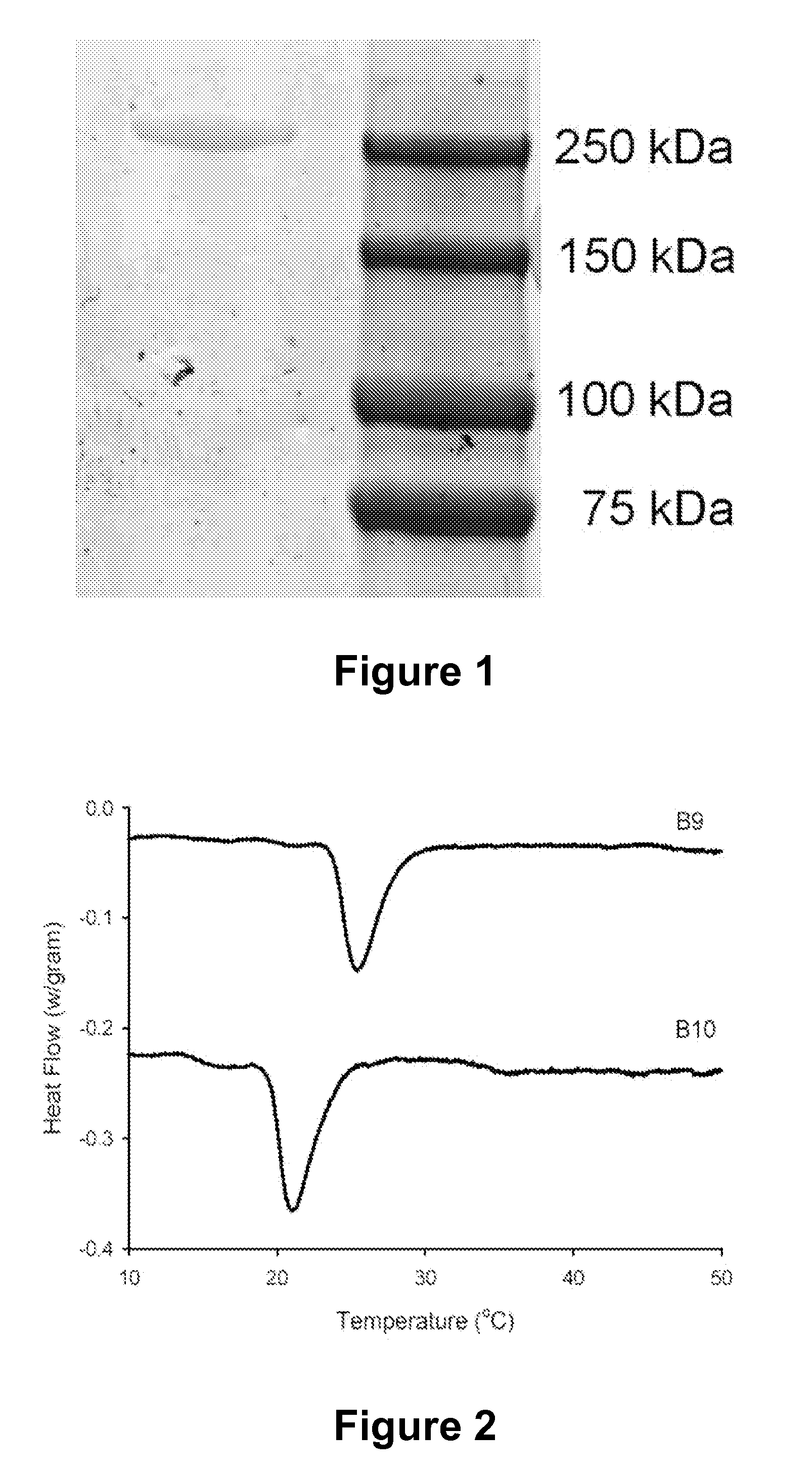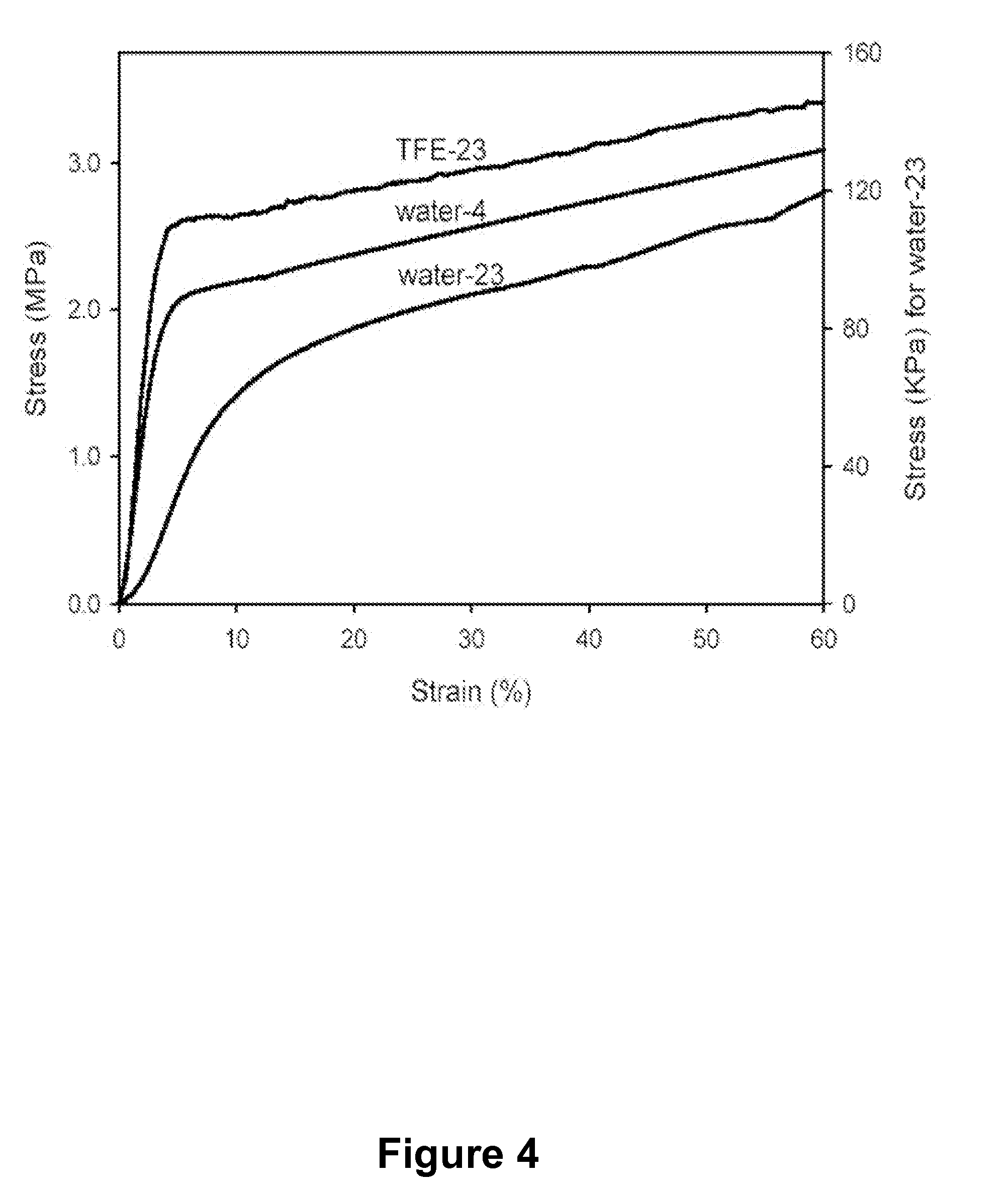Modified Protein Polymers
a technology of protein polymer and modified protein, which is applied in the field of protein, can solve the problems of high rate of restonosis that requires one or more additional procedures, and the physical characteristics of the blood vessel are rather complex, and achieve the effect of suitable mechanical properties and very different desired mechanical properties
- Summary
- Abstract
- Description
- Claims
- Application Information
AI Technical Summary
Benefits of technology
Problems solved by technology
Method used
Image
Examples
example 1
Mechanical Stability and Deformation Responses of Physically Crosslinked Protein-Based Materials
[0103]Recombinant protein polymers are synthesized and examined under various loading conditions in order to assess the mechanical stability and deformation responses of physically crosslinked, hydrated, protein polymer networks designed as triblock copolymers with central elastomeric and flanking plastic-like blocks. Uniaxial stress-strain properties, creep and stress relaxation behavior, as well as the effect of various mechanical preconditioning protocols on these responses are characterized. An analysis of viscoelastic behavior demonstrates that an increase in endblock size improves network stability and that mechanical preconditioning significantly enhances the resilience of hydrated films. Furthermore, the presence of three distinct phases of deformation behavior is revealed upon subjecting physically crosslinked protein networks to step and cyclic loading protocols in which the mag...
example 2
Elastin Fibers as Design Elements for an Arterial Substitute
[0149]With statistics indicating approximately 500,000 procedures for coronary bypass surgery performed in over 300,000 patients each year, cardiovascular disease (CVD) is an unmistakably a growing concern. Since 1900 CVD has been the leading cause of death in the United States, plaguing 70 million Americans and claiming over one million lives per year. Specifically, coronary artery disease accounts for 54% of the CVD deaths annually [1].
[0150]Consequently, the need for a small diameter arterial prosthesis is apparent. Although employing polymers such as polytetrafluorethylene (PTFE) have been successful in the development of large diameter vascular grafts, the fabrication of a durable small diameter prosthesis remains an elusive goal. Biological reactions at the tissue material interface resulting from mechanical or compliance mismatch between native artery and the arterial replacement material lead to their ultimate failu...
example 3
The Effect of a Recombinant Elastin-Mimetic Coating of an ePTFE Prosthesis on Acute Thrombogenicity in a Baboon Arteriovenous Shunt
[0313]The development of durable synthetic vascular grafts has been limited by both surface-induced thrombus formation and anastomotic intimal hyperplasia related, in part, to maladaptive biological responses at the blood-material and tissue-material interfaces. Indeed, within 5 years 30% to 60% of prosthetic vascular grafts implanted in the infrainguinal position will fail [1]. In response to these problems and, in particular, to limit the risk of thrombosis of small caliber prostheses, grafts have been coated with albumin, heparin, or prostacyclin analogues, which inhibit the clotting cascade and platelet reactivity, or with relatively inert materials, such as polyethylene oxide [2-6]. As an alternative strategy to passivate blood-contacting surfaces, several investigators have recently reported that elastin and elastin-derived proteins provide a relat...
PUM
| Property | Measurement | Unit |
|---|---|---|
| Temperature | aaaaa | aaaaa |
| Temperature | aaaaa | aaaaa |
| Temperature | aaaaa | aaaaa |
Abstract
Description
Claims
Application Information
 Login to View More
Login to View More - R&D
- Intellectual Property
- Life Sciences
- Materials
- Tech Scout
- Unparalleled Data Quality
- Higher Quality Content
- 60% Fewer Hallucinations
Browse by: Latest US Patents, China's latest patents, Technical Efficacy Thesaurus, Application Domain, Technology Topic, Popular Technical Reports.
© 2025 PatSnap. All rights reserved.Legal|Privacy policy|Modern Slavery Act Transparency Statement|Sitemap|About US| Contact US: help@patsnap.com



